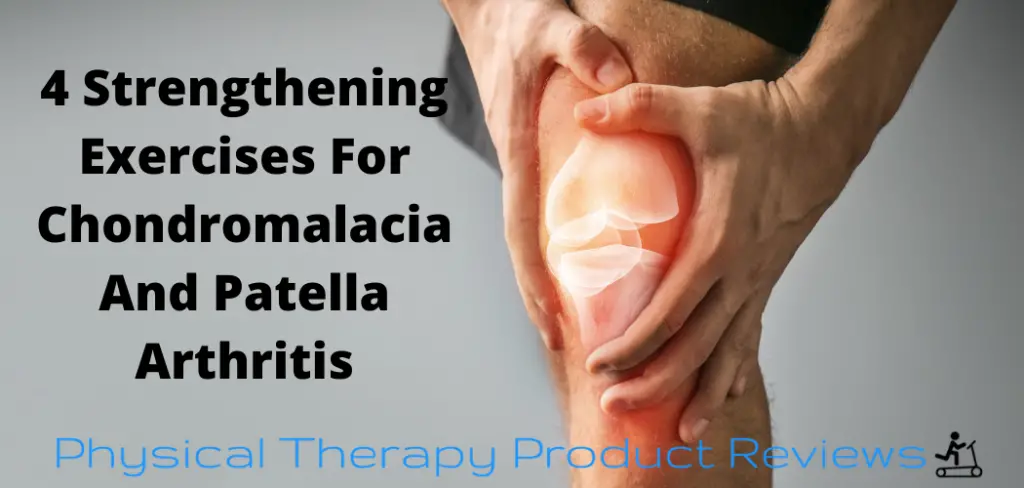Chondromalacia can be a tricky condition to treat. It’s like a chicken-egg situation. The condition likely arose or persisted because of weakness, but now it hurts to exercise! Thankfully, there is an established method of treating this injury that can help improve symptoms without aggravating the pain.
What is Chondromalacia
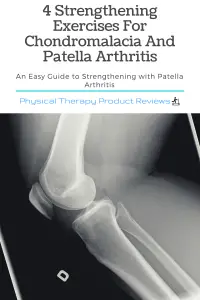 There is a special type of tissue located on the ends of your bones and along the backside of your kneecap. It’s called cartilage and it provides a smooth gliding surface for joints and protects bones from friction during movement. When this cartilage breaks down, it can cause inflammation and pain. The resulting condition is known as chondromalacia.
There is a special type of tissue located on the ends of your bones and along the backside of your kneecap. It’s called cartilage and it provides a smooth gliding surface for joints and protects bones from friction during movement. When this cartilage breaks down, it can cause inflammation and pain. The resulting condition is known as chondromalacia.
Chondromalacia can arise from several instances. Be it the aftermath of trauma or wear and tear, the symptoms are all aggravating. Painful movement of the knee, swelling, maybe even a crunching feeling in the joint.
The Importance of Strengthening for Chondromalacia
Exercise therapy is a highly recommended mode of treatment for patients with chondromalacia. Patients that participate in exercise rehab have statistically significant reductions in pain and improvements in function.
Specific attention is focused on targeting the strength of the hip and knee musculature. Weak hips lead to improper alignment at the knee joint, which can further instigate symptoms and make the condition worse.
4 Strengthening Exercises for Chondromalacia and Patella Osteoarthritis
Clamshell Exercise
Lay on your side in a hook lying position, with knees and hips slightly bent forward. Stack your feet on top of each other, so ankles are in line. Keeping your hips upright (trying not to roll forward or backward) and your feet touching, raise your knee up about 12”, as if your legs were the mouth of a clamshell.
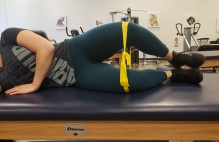
Feel the muscle contraction in your upper glute. Lower your leg back down and repeat for 15 reps, 3 sets on each side.
Advance this exercise by adding a strap weight or resistance band around your knee.
Bridges
Lay on your back with knees bent and feet planted about hip-width apart. Contract your glutes to raise your hips off the floor. Aim to create a straight line from your shoulders to your hips and knees. Hold for 3-5 seconds, then release back down. Repeat for 12 iterations.
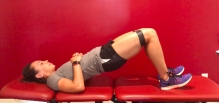
Advance this exercise by adding a resistance band around your knees to further challenge the outer hip musculature.
Eccentric Quad Set
Place a resistance band around your ankles while you are seated on the edge of a chair. Your feet should be planted on the floor. Keeping one foot in place, extend the opposite knee to raise the other foot. Once the knee is extended, slowly lower it back to the floor – about three times as slow as it took you to raise the foot.
Complete 10 repetitions for 3 sets.
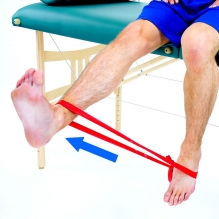
Ball Half Wall Squat
Place a Swiss Ball against a wall and lean your back into it while standing. Step your feet slightly forward. Slowly descend into a squat, as the swiss ball rolls on the wall behind you. Perform a mini squat, descending only as far as your knee feels comfortable. Ensure your knees do not extend beyond your toes. Return to stand quicker than you descended. Complete 12 reps and 3 sets.
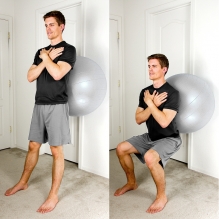
If the repetitions of this exercise aggravate your knee pain, complete a mini wall-sit instead. Find a comfortable squat depth and hold for 30 seconds, return to stand, and repeat 3x.
Advance this exercise by adding a resistance band around your knees and progressing into a deeper squat.
What to Avoid if you have Chondromalacia
Chondromalacia is typically an overuse injury. Avoid high-impact sports, deep squats, and extraneous activities. Anything that increases your symptoms should be avoided.
Avoid the following:
- High impact activities
- Kneeling
- Deep squats
- Excessive stairs
- Long periods of stationary sitting with knees bent
Chondromalacia Tips for Recovery
Let the pain calm down! Treat your knee right by using ice or warm compresses to decrease pain, light massage over your patellar tendon, and a compression sleeve as desired.
Don’t overdo it! Jumping back into sports and activities before your body has had a chance to strengthen supporting musculature will only send you right back to the start. If you notice symptoms increasing, you’re likely doing too much.
Take your time! Breaking from your regular habit of exercise may feel difficult, but you can find other low-impact activities to supplement your rehab program. Instead of running, try swimming or cycling. Be patient with the process – it takes time to strengthen!
Look at your feet! Do you have feet that overpronate (i.e. flat feet)? Grab a pair of supportive inserts from the store to wear for 6 weeks, max.
See your Physical Therapist! Your PT can help design a detailed and structured program for your rehab, custom-tailored to your desired outcomes and activity level. They will also be able to provide hands-on treatment to supplement your exercises, like patellar taping and other pain modalities.
Conclusion
The aggravating knee pain of chondromalacia is…yes, aggravating.
But with the right schedule of strengthening exercises, you can overcome the pain and get back to life!
Works Referenced:
Chondromalacia Patella. Harvard Health Publishing; Harvard Medical School. 2020. https://www.health.harvard.edu/a_to_z/chondromalacia-patella
Habusta SF, Coffey R, Ponnarasu S, Griffin EE. Chondromalacia patella. StatPearls. 2021. https://www.ncbi.nlm.nih.gov/books/NBK459195/
Willy RW, et al. Patellofemoral Pain. Journal of Orthopaedic & Sports Physical Therapy. 2019; 49(9). https://www.jospt.org/doi/pdf/10.2519/jospt.2019.0302
From the Physical Therapy Blog
How to Stay Active After Cervical Fractures: Expert Tips and Advice
Dealing with Painful Stairs After Ankle Replacement Surgery
Walking After a Total Ankle Replacement: Tips for a Successful Recovery
Exercises While Non-Weight Bearing After Ankle Replacement: Elevation, AROM, Leg Raises, and More
Ankle Pain with Stairs: Causes and Home Treatment Options
5 Common Mistakes You’re Making After an Ankle Sprain
Disclaimer: The information provided in this post is for educational purposes only. This is not a substitute for a medical appointment. Please refer to your physician before starting any exercise program.
